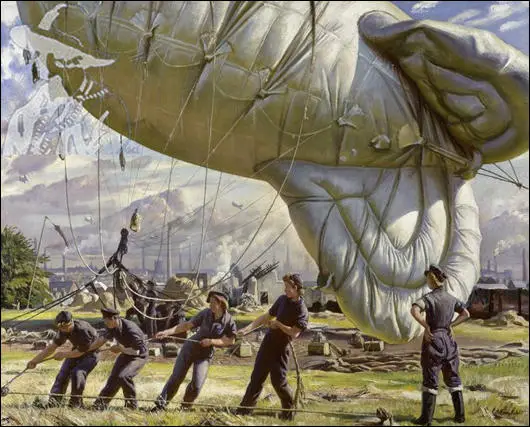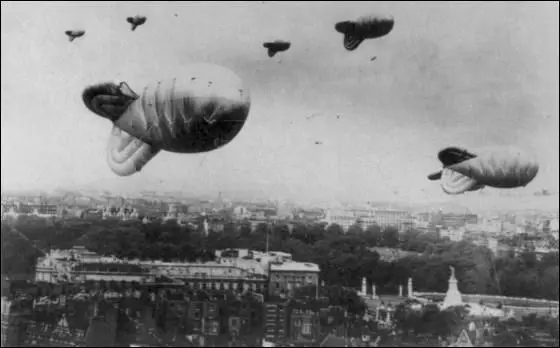Barrage Balloons
In 1938 the RAF Balloon Command was established to protect cities and key targets such as industrial areas, ports and harbours. The main objective was to prevent low fights and pinpoint bombing by the Luftwaffe. This forced them to fly higher and into the range of concentrated anti-aircraft fire - anti-aircraft guns could not traverse fast enough to attack aircraft flying at low altitude and high speed. These silver-coloured barrage balloons, were 66 feet long and 30 feet high, filled with 20,000 cubic feet of hydrogen and tethered to the ground by steel cables. By the middle of 1940 there were 1,400 balloons, a third of them over the London area. (1)
These large serene and beautiful shapes were to stay poised over British cities for the rest of the war. The journalist, James L. Hodson, described them as "shinning silver in the sun, or turning pink or golden or shades of blue in the varied lights from dawn to evening, their cable singing some kind of tune, maybe, in a high wind, and just occasionally, the balloon itself, if something has gone wrong, turning over and over like a playful porpoise or, again, lashing about with the fury of a wounded whale." (2)

Each balloon was moored to a wagon by a cable. These cables were strong enough to destroy any aircraft colliding with them. On the wagon was a winch that enabled the men of Balloon Command to control the height of the barrage balloon. It has been claimed that in the first months of war, the balloons inspired an irrational sense of immunity among civilians. This was encouraged by an early propaganda film, The Lion Has Wings (1939), which depicted a mass raid Luftwaffe bombers turning back in fear and confusion at the sight of Britain's terrifying balloon barrage. (3)
As Ada Ryder pointed out, these balloons were difficult to control: "The balloon could behave very dangerously, and the weather was the number-one enemy. In high winds we had to 'storm bed' it; that was, to bring it down to the concrete base and anchor it with concrete blocks, each one weighing fifty-six pounds. The nose had always to be in the wind, otherwise it would break away, dragging thousands of feet of steel cable with it. That cable was lethal. The corporal would stand on site, eight of us each by a concrete block, and at her command we'd all move together about six inches at a time. The wind would be howling, rain and hail lashing us, and it would take about two hours to get the balloon into wind. We'd just finish, all tired out, and the wind would change, so out we'd go again. It wasn't funny, I'll tell you, in tin hat, pyjamas, greatcoat over the top, and big boots on our bare feet! Sometimes we were machine-gunned trying to fly the balloon as a raid came in." (4)
Barrage balloons were fairly easy to destroy but they did have their successes. "One Saturday we were clearing up the billet when the crackle of machine guns and cannon guns was heard. The men grabbed their rifles and dashed out to the Balloon site. The sky was full of AA shell bursts while machine guns were going off everywhere. Several balloons were coming down in flames, ours included. The next balloon to us was being hauled down just as fast as the winch could pull it. It was about 800 feet off the ground when one of the Messerschmitt 109s decided that he would try and get it. He swept over our heads and brought it down all right. But as he turned and banked away to sea again he seemed to be standing still in the air for a few seconds. The range was about 700 feet. The NCO yelled 'Fire!' Everyone pumped as many rounds as he could into it. The plane kept straight on with his dive out to sea, while a thin trail of smoke poured out from behind. When we last saw it, it was going down behind a breakwater out to sea. We did not stand about wondering if we had got it as we had a new balloon to inflate and fly. It was when we had finished this and had the balloon barrage up again that we leant we had been given the credit for shooting down a Messerschmitt 109." (5)

The record for Balloon Command was not very good. During six years of war balloon barrages brought down approximately 100 aircraft, yet three-quarters of these were Allied planes. Just 24 German aircraft are known to be victims of these balloons. They were also dangerous to civilians on the ground. On 13th June, a Heinkel He III struck a balloon cable over Newport, and plunged into a built-up area, killing two children. In October, an exploding barrage balloon killed two firemen in Lambeth. However, they undoubtedly boosted civilian morale, and would later bring down 278 VI flying bombs. (6)
Primary Sources
(1) Harold Nicolson, diary entry (1st September, 1939)
Motor up ... to London. There are few signs of any undue activity beyond a few khaki figures at Staplehurst and some schoolboys filling sandbags at Maidstone. When we get near London we see a row of balloons hanging like black spots in the air. Go down to the House of Commons at 5.30. They have already darkened the building and lowered the lights... I dine at the Beefsteak (Club).... When I leave the Club, I am startled to find a perfectly black city. Nothing could be more dramatic or give one more of a shock than to leave the familiar Beefsteak and to find outside not the glitter of all the sky-signs, but a pall of black velvet.
(2) A sergeant in the Women's Auxiliary Air Force, quoted in A Roof Over Britain, The Official History of the AA Defences (1943)
One Saturday we were clearing up the billet when the crackle of machine guns and cannon guns was heard. The men grabbed their rifles and dashed out to the Balloon site. The sky was full of AA shell bursts while machine guns were going off everywhere. Several balloons were coming down in flames, ours included. The next balloon to us was being hauled down just as fast as the winch could pull it. It was about 800 feet off the ground when one of the Messerschmitt 109s decided that he would try and get it. He swept over our heads and brought it down all right. But as he turned and banked away to sea again he seemed to be standing still in the air for a few seconds. The range was about 700 feet. The NCO yelled 'Fire!' Everyone pumped as many rounds as he could into it. The plane kept straight on with his dive out to sea, while a thin trail of smoke poured out from behind. When we last saw it, it was going down behind a breakwater out to sea. We did not stand about wondering if we had got it as we had a new balloon to inflate and fly. It was when we had finished this and had the balloon barrage up again that we leamt we had been given the credit for shooting down a Messerschmitt 109.
(3) Ada Ryder, interviewed in Women Who Went to War (1988)
The balloon could behave very dangerously, and the weather was the number-one enemy. In high winds we had to 'storm bed' it; that was, to bring it down to the concrete base and anchor it with concrete blocks, each one weighing fifty-six pounds. The nose had always to be in the wind, otherwise it would break away, dragging thousands of feet of steel cable with it. That cable was lethal. The corporal would stand on site, eight of us each by a concrete block, and at her command we'd all move together about six inches at a time. The wind would be howling, rain and hail lashing us, and it would take about two hours to get the balloon into wind. We'd just finish, all tired out, and the wind would change, so out we'd go again. It wasn't funny, I'll tell you, in tin hat, pyjamas, greatcoat over the top, and big boots on our bare feet! Sometimes we were machine-gunned trying to fly the balloon as a raid came in.
(4) Joan Miller, One Girl's War (1970)
During the spring and summer of 1944 I went down to Kent nearly every weekend to visit my aunt and see my dog. I used to take the train to Tonbridge and bike the rest of the way, an uphill journey: my aunt's house was right out in the open countryside near Plaxtol. It was in her garden that she and I first saw a flying bomb.. We had heard it as it passed directly overhead, and dashed into the garden to find out what it was. It was still making that peculiar 'rump, rump' noise and as far as I remember it had a burning red 'nose'. It looked so odd that we turned to one another and burst out laughing; then came the fearful silence, followed by a crash - fortunately on open ground some way away.
The house was directly in the path of these flying bombs. At first a barrage of balloons was put up in an effort to bring them down; this proved useless, however, and the next move was to have the bombs chased by Spitfires and shot down. This was not very successful either, until they hit on the idea of using two fighters to every buzz bomb, approaching the latter at a V angle.
